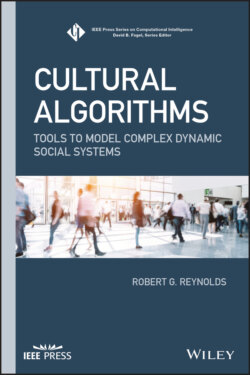Читать книгу Cultural Algorithms - Robert G. Reynolds - Страница 29
The Logistics Function
ОглавлениеThe logistics function (Figure 2.7) utilized by the CAT System, notably in the update mechanism for the topographic of the ConesWorld fitness function, is a recursive function that generates a value between 0 and 1. This value is then used by the update mechanism to select a fractional amount of the allowable rate of change that the system specifies.
Given an A value between 0 and 4, successive iterations of the logistics function will generate a fluctuation between the values of 0 and 1. The frequency of this fluctuation is dependent on the size of the A value. Due to the recursive nature of the function, low values of A will result in subsequent values of Y(n) approaching a steady output that will cease to fluctuate after a sufficient number of iterations. For this reason, using lower values of A in the ConesWorld simulation will result in the appearance of smooth, predictable, near‐linear transitions from one update to the next.
However, as the A value approaches 3, the resulting fluctuations becomes more self‐sufficient and will maintain a steady, regular frequency between two absolutes, which its peaks and valleys will trend toward. For these cases, it is possible to have subsequent steps of the logistics function vary, but in predictable ways. As each cone in the ConesWorld simulation freshly calculates the logistics function with the next iteration of Y(n), alternating cones querying it for their rate of change will receive alternating high and low rates from it.
After exceeding an A value of 3.33, the logistics function enters into a self‐sufficient, non‐maintaining erratic frequency with relatively unpredictable shifts in frequency, without ever stabilizing to a constant, repetitive cycle. As seen in Figure 2.8, the lower values of A, ranging from 0 to 3 in the forefront, quickly reduce to a singular output after a brief initial period. After A reaches 3, the frequency does not reduce, but rather becomes a self‐perpetuating frequency that continues indefinitely without diminishing.
In those rows of the graph beyond 3.33, the pattern becomes erratic, with each subsequent iteration of the logistics function taking a dramatic, seemingly unpredictable movement that bears little relation to the patterns produced by lower values of A. It should also be noted that even with this erratic fluctuation the resulting Y(n) values are still within the range of 0 and 1. However, should the A value exceed 4, then the system will destabilize and quickly break out of the given range.
Figure 2.7 The CAT System Logistics Function.
Figure 2.8 A three‐dimensional visualization of successive iterations of the logistics function across increasing values of A.
